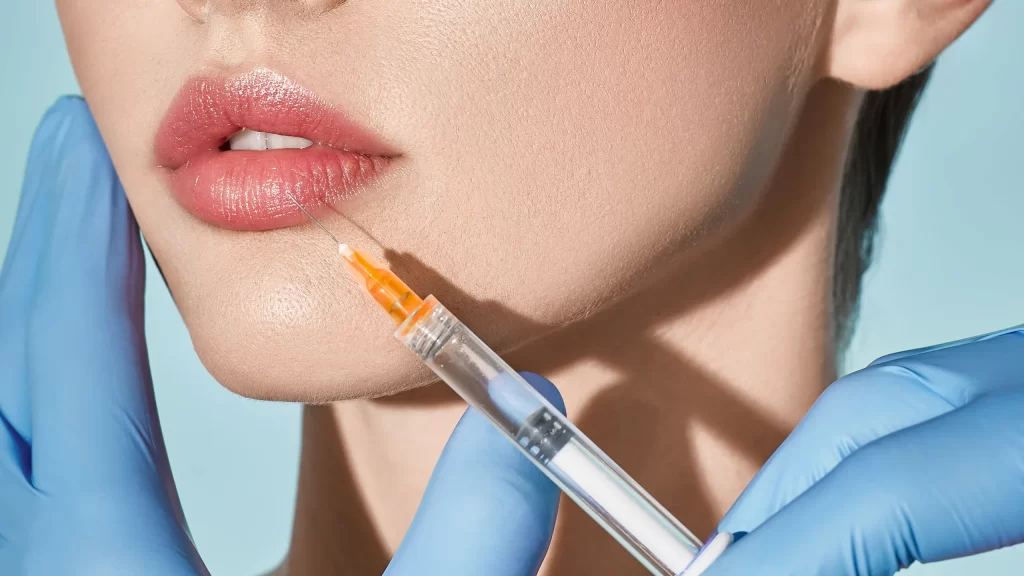The lip filler procedure has emerged as a great way to safely enhance the look of your lips without undergoing cosmetic surgery. This minimally invasive procedure has become a popular choice for those seeking to boost their confidence and achieve a desired aesthetic look.
This article delves into the lip filler procedure. We will give you a comprehensive guide on what lip fillers are, what the procedure is like as well as what the risks are when it comes to lip fillers.
Understanding Lip Fillers
Lip fillers, commonly referred to as lip injections or dermal lip fillers, are substances injected into the lips to increase volume, improve symmetry, and enhance overall appearance. These fillers have revolutionized the concept of non-surgical cosmetic enhancements, offering a relatively quick and efficient way to achieve fuller, plumper lips.
A Brief History
The quest for fuller lips is not a modern phenomenon. The use of substances to enhance lip volume dates back to ancient times. However, the evolution of lip fillers as we know them today began in the 20th century, with the development of safer, more effective materials.
Types of Fillers
The most common types of lip fillers are based on Hyaluronic Acid (HA), a naturally occurring substance in the body known for its hydrating properties. Other types, such as those made from collagen, were popular in the past but have seen a decline due to the superior results and safety profile of HA fillers. HA fillers like Juvederm and Restylane are renowned for their natural-looking results and reversible nature.
Lip Filler Pre-Procedure
The journey to lip fillers starts with a consultation. Your provider should always discuss your aesthetic goals, expectations, and the best type of filler to achieve them. The practitioner will evaluate your facial anatomy and may use imaging software or mark up your face to simulate potential outcomes.
Medical Evaluation
A thorough medical evaluation follows the consultation. Your practitioner will review your medical history, including any allergies, previous surgeries, and current medications, to ensure the safety and suitability of the procedure.
Preparing for the Procedure
Before the procedure, patients may be advised to avoid certain medications such as aspirin or anti-inflammatory drugs, which can increase the risk of bruising. Dietary guidelines, such as avoiding alcohol, may also be recommended.
The Lip Filler Procedure Step-by-Step
Step 1: Cleansing and Preparation
On the day of the procedure, the lip area is cleansed thoroughly to minimize the risk of infection. This step is crucial for a safe and successful treatment.
Step 2: Numbing
Comfort during the procedure is paramount. A numbing cream or local anesthesia is typically applied to the lips to minimize discomfort during the injections.
https://www.tiktok.com/t/ZT845LBc7/
Step 3: Marking the Target Areas
Your practitioner may then mark specific areas on your lips where the filler will be injected. This step is one way for your provider to achieve symmetry and the desired aesthetic outcome. The precision here ensures that the results align with your initial consultation discussion.
Step 4: The Injection Process
The actual injection process is relatively quick, typically taking less than 20 minutes. Using a fine needle, the filler is carefully injected into the predetermined areas. The amount used varies depending on the desired volume and the specific areas being treated. During this process, the practitioner might massage the areas to evenly distribute the filler and sculpt the lips to the desired shape.
Step 5: Immediate Post-Injection Care
Once the injections are complete, ice may be applied to alleviate swelling and minimize bruising. Patients are usually observed for a short time for any immediate reactions before being allowed to leave.
Post-Procedure: Recovery and Results
Post-procedure, it’s common to experience some swelling and bruising, which typically subsides within a week. It’s important to follow the specific aftercare instructions provided by your practitioner, which may include avoiding pressure on the lips or face, strenuous exercise, extreme temperatures, and direct sunlight for a certain period.
Long-Term Care and Maintenance
To maintain the results of lip fillers, follow-up appointments are essential. The longevity of fillers varies, but most HA fillers last between six months to a year. Factors such as metabolism, lifestyle, and the type of filler used can influence this duration.
Risks and Considerations for Lip Procedures
While lip fillers are generally safe, they are not without risks. Common side effects include redness, swelling, and bruising at the injection sites. More serious complications, though rare, can include infection, allergic reactions, or vascular compromise (where the filler blocks a blood vessel).
The Importance of a Qualified Practitioner
Choosing an experienced and qualified practitioner is paramount. This reduces the risk of complications and ensures that the procedure is performed safely and effectively.
Myths vs. Reality
Debunking Misconceptions
Common myths surrounding lip fillers include the idea that they always look unnatural or lead to permanently stretched skin. In reality, when performed correctly, lip fillers can look natural and do not permanently stretch the skin.
Setting Realistic Expectations
Understanding the realistic outcomes of lip fillers is vital. While they can enhance appearance, they should not be seen as a solution to deeper self-esteem issues.
Cost and Accessibility
The cost of lip fillers varies widely based on geographic location, the type of filler used, and the practitioner’s expertise. It’s important to consider this investment and any potential follow-up treatments required.
Lip fillers are one of the most popular minimally invasive cosmetic procedures. To ensure that they are done correctly, always consult with a qualified professional to ensure safety and the best possible outcome.
Dr. Sergio Guiteau is a physician who is board certified in Family Practice and Sports Medicine with added certifications in Aesthetic Medicine. He specializes in Preventive Medicine, Sports Medicine, and Anti-Aging Medicine and blogs on Advancedrejuv.com/blog

